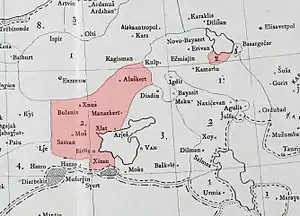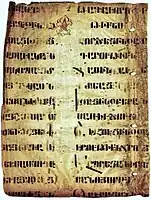| Mush dialect | |
|---|---|
| Mush | |
| Մշոյ բարբառ | |
| Native to | Georgia, Armenia |
| Ethnicity | Armenian people |
Native speakers | (undated figure of 3,000) |
Indo-European
| |
| Armenian alphabet | |
| Language codes | |
| ISO 639-3 | (included in Western Armenian [hyw]) |
| Glottolog | muss1244 |

Mush dialect (Armenian: Մշոյ բարբառ, Mšo barbař) is a Western Armenian dialect formerly spoken in the city of Mush (Muş) and the historic region of Taron, in present-day eastern Turkey. As a result of the extermination of the native Armenian population during the genocide of 1915, the dialect is almost completely extinct today with only several thousand native speakers in a number of villages in Armenia and three Armenian-populated villages in the Samtskhe-Javakheti province of Georgia.
Area spoken
According to Hrachia Adjarian in the early 20th century, the Mush dialect was spoken in the cities of Bitlis, Xizan (Hizan), Khlat (Xlat), Arjesh, Bulanikh, Manazkert, Khnus (Xnus), and Alashkert. The dialect was spread to the west of Lake Van.[2]
During the Russo-Turkish War of (1877–78), Armenians from Mush and Alashkert established villages in the Erivan Governorate: in Aparan and south of Novo-Bayazit (present-day Gavar). According to Adjarian there were 21 Armenian villages in the Erivan Governorate where the Mush dialect was spoken. Another group of Armenians from Khnus settled near Akhalkalaki, particularly in three villages: Heshtia, Toria and Ujmana.[2][3]
According to a 1955 article the Mush dialect was spoken in villages located in the following districts (raion) of Soviet Armenia: Talin, Aparan, Artik, Aghin, Ejmiatsin, and Martuni.[4]
One notable village in Armenia where the dialect is still spoken is Kamo in the northwestern Shirak Province.[5][6]
Notable speakers
- Gegham Ter-Karapetian (Msho Gegham) (1856–1918), writer, poet[7]
- Arabo (1863–1893), fedayi
- Aghbiur Serob (1864–1899), fedayi
- Hrayr Dzhoghk (1864–1904), fedayi
- Kevork Chavush (1870–1907), fedayi
- Makhluto (1872–1956), fedayi
- Armenak Shahmuradyan (1878–1939), singer
- William Saroyan (1908–1981), US-born writer[8]
- Khachik Dashtents (1910–1981), writer
Songs in Mush dialect
- "Zartir lao" - ashugh Fahrat (1890s)
- "Dle yaman" - written down by Komitas Vardapet in early 20th century, performed by Lusine Zakaryan, Flora Martirosian, Isabel Bayrakdarian,
- "Lily" - Armenoids (2007)
- Gulo - Hasmik Harutyunyan
References
- Notes
- ↑ Adjarian 1909, pp. 44–45.
- 1 2 Adjarian 1909, p. 48.
- ↑ Simavoryan, Arestakes (21 May 2009). "Ախալքալաքի և Նինոծմինդայի հայ կաթոլիկ համայնքների խնդիրները [Problems of the Catholic Armenian communities in Akhalkalaki and Ninotsminda districts]" (in Armenian). Noravank Foundation.
Միավորող է նաև լեզվի գործոնը՝ Մշո բարբառը...
- ↑ Baghdasarian 1955, p. 69.
- ↑ "Կամո [Kamo]". shirak.mtaes.am (in Armenian). Ministry of Territorial Administration and Emergency Situations of Republic of Armenia. Archived from the original on 2015-10-25.
Բնակչությունը հիմնականում հայեր են և խոսում են մշո բարբառով:
- ↑ ""Թող ընպես ընեն, որ էս երկրում գյուղացին կրնանա շունչ քաշե, ես էլի կդառնամ հող կմշակեմ",-ասում է Կամո գյուղի բնակիչ Զարզանդ Գորգորյանը". Hetq Online (in Armenian). 28 April 2011. Archived from the original on 10 July 2015. Retrieved 8 August 2015.
Բնակչության շրջանում գերիշխում է Մշո բարբառը:
- ↑ Hacikyan, Agop Jack (2005). The Heritage of Armenian Literature: From The Eighteenth Century To Modern Times. Detroit: Wayne State University Press. p. 566. ISBN 9780814332214.
- ↑ YouTube video of William Saroyan's visit to Soviet Armenia in the 1970s. He clearly speaks the Mush dialect.
- Bibliography
- Baghdasarian, S. (1955). "Դիտողություններ Մշո բարբառի մասին". Bulletin of the Academy of Sciences of the Armenian SSR: Social Sciences (in Armenian). Yerevan: Armenian National Academy of Sciences: 67–82.
- Antosian, S. (1958). "Ուսումնասիրություն Մշո բարբառի մասին". Bulletin of the Academy of Sciences of the Armenian SSR: Social Sciences (in Armenian). Yerevan: Armenian National Academy of Sciences (11): 99–102. Retrieved 28 March 2013.
- Further reading
- Patkanov, Kerovbe (1875). Mushkii dialekt [Dialect of Mush] (in Russian). St. Petersburg: Russian Academy of Sciences. — includes folklore genres in Mush dialect
- Mseriants, Levon [in Russian] (1897). Этюды по армянской диалектологии (in Russian). Moscow.
{{cite book}}: CS1 maint: location missing publisher (link) - Adjarian, Hrachia (1909). Classification des dialectes arméniens (in French). Paris: Librairie Honore Champion.
- Baghdasarian-Tapaltsian, S. H. (1958). Msho barbare [The Dialect of Mush] (in Armenian). Yerevan: Armenian National Academy of Sciences. — a wide study on the dialect, includes 15 stories, 710 proverbs, sayings, blessings
